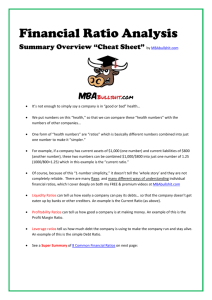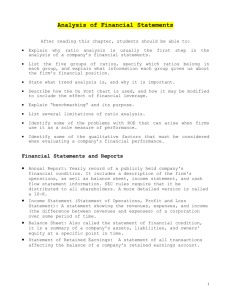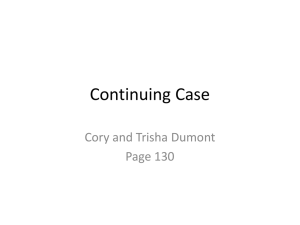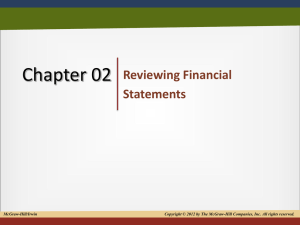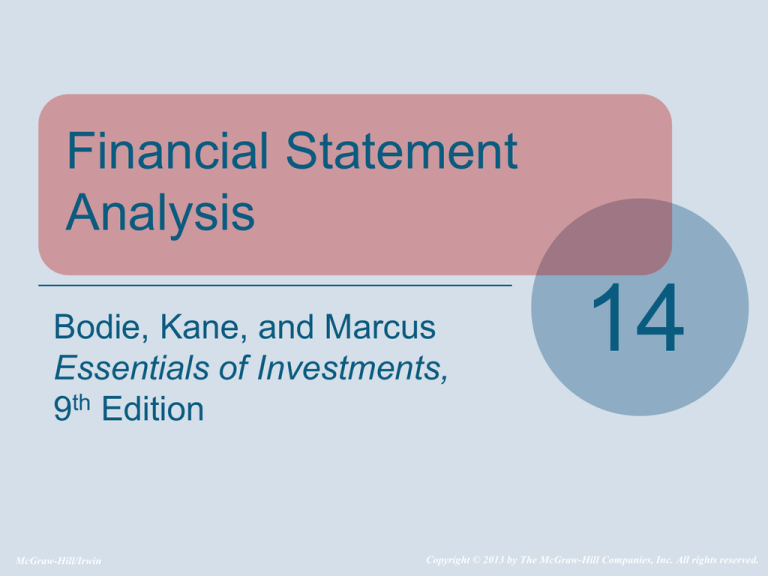
Financial Statement
Analysis
Bodie, Kane, and Marcus
Essentials of Investments,
9th Edition
McGraw-Hill/Irwin
14
Copyright © 2013 by The McGraw-Hill Companies, Inc. All rights reserved.
14.1 Major Financial Statements
• Income Statement
• Financial statement showing firm’s revenues
and expenses during specified period
• Economic Earnings
• Real flow of cash firm could pay without
impairing productive capacity
• Accounting Earnings
• Earnings of a firm as reported on income
statement
14-2
14.1 Major Financial Statements
• Balance Sheet
• Accounting statement of firm’s financial position
at specified time
• Statement of Cash Flows
• Financial statement showing firm’s cash
receipts and cash payments during specified
period
14-3
Table 14.1 Home Depot’s Income Statement
$ Million
Operating Revenues
Net sales
Operating Expenses
Cost of goods sold
Selling, general, & administrative expenses
Other
Depreciation
Earnings before interest and income taxes
Interest expense
Taxable income
Taxes
Net income
Allocation of net income
Dividends
Addition to retained earnings
Percent of
Revenue
67,997
100.0%
42,975
15,849
1,652
1,718
63.2%
23.3%
2.4%
2.5%
5,803
530
5,273
1,935
3,338
8.5%
0.8%
7.8%
2.8%
4.9%
1,569
1,769
2.3%
2.6%
Note: Sums subject to rounding error
14-4
Table 14.2 Home Depot’s Balance Sheet
Panel A: (millions of dollars)
Assets
Current assets
Cash and marketable securities
Receivables
Inventories
Other current assets
Total current assets
Fixed assets
Tangible fixed assets
Property, plant, and
equipment
Long-term Investments
Total tangible fixed assets
Intangible fixed assets
Goodwill
Total fixed assets
Other assets
Total assets
Percent of
$ million total assets
545
1,085
10,625
1,224
13,479
1.4%
2.7%
26.5%
3.1%
33.6%
Liabilities and shareholders' equity
Current liabilities
Debt due for repayment
Accounts payable
Other current liabilities
Total current liabilities
1,042
7,903
1,177
10,122
2.6%
19.7%
2.9%
25.2%
8,707
2,407
21.7%
6.0%
Total liabilities
21,236
52.9%
Shareholders' equity
Common stock and other paid-in
capital
Retained earnings
Total shareholders' equity
3,894
14,995
18,889
9.7%
37.4%
47.1%
Total liabilities and shareholders' equity
40,125
100.0%
Long-term debt
Other long-term liabilities
25,060
139
25,199
62.5%
0.3%
62.8%
1,187
3.0%
26,386
65.8%
260
0.6%
40,125
100.0%
Percent of
$ million total assets
Source: Home Depot Annual Report, year ending January 2011
14-5
Table 14.3 Home Depot’s Statement of Cash Flows
$ Million
Cash provided by operations
Net income
$3,338
Adjustments to net income
Depreciation
1,718
Changes in working capital
Decrease (increase) in receivables
Decrease (increase) in inventories
Increase (decrease) in other current liabilities
Changes due to other operating activities
Total adjustments
Cash provided by operations
(102)
(355)
(269)
255
$1,247
4,585
Cash flows from investments
Gross investment in tangible fixed assets
Investments in other assets
Cash provided by (used for) investments
($1,096)
84
($1,012)
Cash provided by (used for) financing activities
Additions to (reductions in) long-term debt
Net issues (repurchases of) shares
Dividends
Other
Cash provided by (used for) financing activities
($31)
(2,504)
(1,569)
(347)
($4,451)
Net increase in cash
($878)
Source: Home Depot Annual Report, year ending January 2011.
14-6
14.2 Measuring Firm Performance
• Investment Decisions
• Efficiency of assets
• Profitability of sales
• Financing Decisions
• Leverage
• Liquidity
14-7
Figure 14.1 Ratios
14-8
14.3 Profitability Measures
•
14-9
Table 14.4 Nodett’s Profitability over Business Cycle
14-10
Table 14.5 Impact of Financial Leverage on ROE
*Somdett’s after-tax profits equal .6(EBIT − $3.2 million).
†Somdett’s equity is only $60 million.
14-11
14.3 Profitability Measures
• Economic Value Added
• Measure of dollar value of firm’s return in
excess of opportunity cost
• Also known as residual income
• Spread between ROA and cost of capital
multiplied by capital invested in firm
14-12
Table 14.6 Economic Value Added, 2011
EVA
($ billion)
Capital ($
billion)
ROA
(%)
Cost of
Capital (%)
ExxonMobil
6.90
171.31
10.8
6.8
Intel
4.29
52.87
16.1
8.0
Walmart
3.87
125.80
8.6
5.5
GlaxoSmithKline
3.02
34.75
15.3
6.6
Google
2.60
61.38
12.0
7.7
Hewlett Packard
-0.91
68.86
5.9
7.2
AT&T
-1.60
183.99
4.6
5.5
Honda
-3.63
105.20
1.7
5.1
Source: Authors' calculations using data from finance.yahoo.com
14-13
14.4 Ratio Analysis
•
14-14
14.4 Ratio Analysis
• Decomposition of ROE
• Total asset turnover (ATO)
• Annual sales generated by each dollar of assets
(Sales/Assets)
• Interest coverage ratio
• Financial leverage measure
• EBIT divided by interest expenses
14-15
14.4 Ratio Analysis
• Decomposition of ROE
• Leverage ratio
• Measure of debt to total capitalization of firm
• ROE = Tax burden × Interest burden × Margin ×
Turnover × Leverage
• ROA = Margin × Turnover
14-16
Figure 14.2 Median ROA, Profit Margin, and Asset
Turnover for 23 Industries
14-17
Table 14.7 Ratio Decomposition Analysis for Nodett and
Somdett
14-18
Table 14.8 Differences between Profit Margin and Asset
Turnover across Industries
14-19
14.4 Ratio Analysis
•
14-20
14.4 Ratio Analysis
• Liquidity Ratios
• Liquidity: Ability to convert assets into cash at
short notice
• Current ratio: Current assets/Current liabilities
• Quick ratio: Measure of liquidity similar to
current ratio; excludes inventories
• Cash ratio: Cash and marketable securities to
current liabilities
14-21
Table 14.9 Growth Industries Financial Statements
2011
2012
2013
2014
14-22
14.4 Ratio Analysis
•
14-23
Table 14.10A Summary of Financial Ratios
14-24
Table 14.10B Summary of Financial Ratios
14-25
Figure 14.3 DuPont Composition for Home Depot
30
Turnover x 10
25
ROA
Ratio
20
15
Profit margin
10
5
0
2001
2002
2003
2004
2005
2006
2007
2008
2009
2010
2011
14-26
Table 14.11 Financial Ratios: Major Industry Groups
LT Debt Interest
Assets Coverage
Current
Ratio
Quick
Ratio
Asset
Turnover
Profit
Margin
(%)
Return
on
Assets
(%)
Return on
Equity (%)
Payout
Ratio
All manufacturing
0.21
5.01
1.42
0.98
0.84
8.03
6.78
17.12
0.27
Food products
0.29
3.83
1.28
0.76
1.15
5.95
6.87
5.59
0.87
Clothing
0.19
7.02
2.32
1.31
1.28
9.29
11.91
22.03
0.21
Printing/publishing
0.40
3.04
1.52
1.19
1.32
7.40
9.75
25.69
0.23
Chemicals
0.26
4.41
1.28
0.94
0.51
14.08
7.14
17.38
0.30
Drugs
0.25
4.47
1.28
1.00
0.35
20.44
7.08
16.26
0.28
Machinery
0.17
5.18
1.39
0.92
0.83
8.78
7.25
16.27
0.19
Electrical
0.12
4.37
1.17
0.75
0.51
7.06
3.63
11.47
0.59
Motor vehicles
Computer and
electronic
0.14
4.28
1.29
0.99
1.17
4.15
4.86
22.58
0.19
0.15
5.12
1.62
1.33
0.55
7.42
4.11
15.23
0.18
Source: U.S. Department of Commerce, Quarterly Financial Report for Manufacturing, Mining and Trade Corporations, third quarter 2011.
Available at http://www2.census.gov/econ/qfr/current/qfr_pub.pdf
14-27
14.5 Illustration of Financial Statement Analysis
• Example: Growth Industries
• Sales, assets, operating income increased 20%
• ROE declining
• ROA not declining
• Rapid increase in year-to-year short-term debt
and interest expense
14-28
Table 14.12 Key Financial Ratios: Growth Industries
14-29
Table 14.13 Growth Industries Cash Flows
14-30
14.6 Comparability Problems
• Inventory Valuation
• LIFO
• Last-in first-out inventory valuation
• FIFO
• First-in first-out inventory valuation
14-31
14.6 Comparability Problems
• Depreciation
• Economic
• Amount of operating cash flow that must be
reinvested in firm to sustain real cash flow
• Accounting
• Amount of acquisition cost of asset that is
allocated to each accounting period over
arbitrarily specified life of asset
14-32
14.6 Comparability Problems
• Fair Value Accounting
• Use of current market values rather than
historic costs in firm’s financial statements
• Relies heavily on estimates
14-33
14.6 Comparability Problems
• Quality of Earnings
• Realism and sustainability of reported earnings
• Factors that affect quality of earnings
• Allowance for bad debt
• Nonrecurring items
• Earnings smoothing
• Revenue recognition
• Off-balance-sheet assets and liabilities
14-34
14.6 Comparability Problems
• International Accounting Conventions
• Reserving practices
• Subject to more managerial discretion in U.S.
• Depreciation
• Other countries do not allow dual sets of
accounts
• Most firms in foreign countries use accelerated
depreciation
• Intangibles
• Treatment varies wildly from country to country
14-35
14.6 Comparability Problems
• International Accounting Conventions
• International Financial Reporting Standards
(IFRS)
• Principles-based set of accounting rules
adopted by around 100 countries, including
European Union
14-36
Figure 14.4 Adjusted versus Reported Price-Earnings Ratios
14-37

